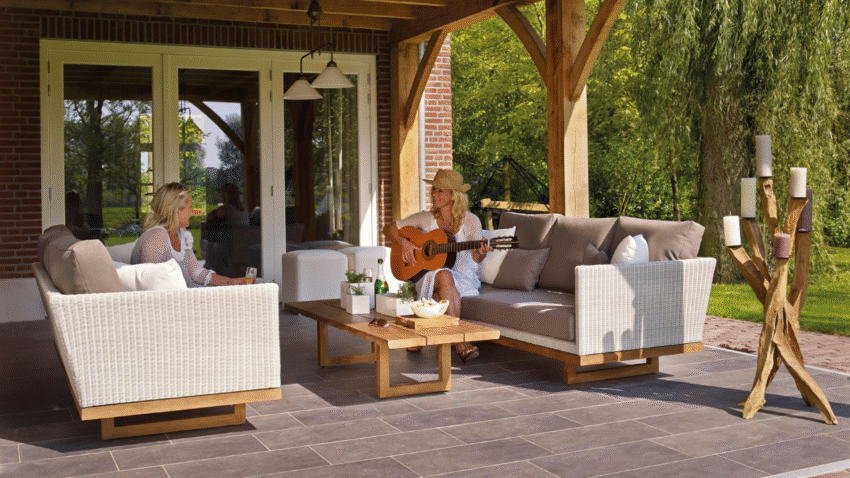Introduction
Decking is constantly exposed to sun, rain, foot traffic, and temperature changes, which slowly break down its protective coating. Without that barrier, wood becomes vulnerable to moisture, fading, cracking, and even rot. Learning how to reapply protective coating to decking keeps your outdoor space looking beautiful while extending its lifespan. If your deck looks faded, water no longer beads on the surface, or you notice peeling finish, this guide will walk you through re-coating it the right way.
Why Protective Coatings Matter
Protective coatings—whether sealers, stains, or paints—serve several important purposes:
- Moisture resistance: Prevents water from soaking into the wood.
- UV protection: Reduces sun damage and fading.
- Durability: Adds a shield against scratches, stains, and foot traffic.
- Improved appearance: Restores natural beauty or color to the decking.
- Longevity: Extends the life of wood, saving money on replacements.
Reapplying every 1–3 years (depending on product and exposure) ensures ongoing protection.
Step-by-Step Guide to Reapplying Protective Coating to Decking
1. Inspect the Deck
Start by checking the condition of your deck:
- Look for peeling or flaking finish.
- Check for graying or faded areas.
- Sprinkle water on the surface—if it soaks in instead of beading, it’s time to reapply.
If wood is soft, cracked, or rotted, repairs must be made before coating.
2. Gather Tools and Materials
You’ll need:
- Deck cleaner or brightener.
- Stiff-bristle brush or broom.
- Pressure washer (optional, for deep cleaning).
- Sandpaper or power sander.
- Paint tray, roller, or brush.
- Protective deck coating (stain, sealer, or paint).
- Painter’s tape and drop cloths.
- Safety gear: gloves, goggles, mask.
3. Clean the Deck Thoroughly
A clean surface is essential for proper adhesion:
- Sweep away dirt, leaves, and debris.
- Apply deck cleaner or a mix of dish soap and water.
- Scrub with a stiff brush or broom.
- Rinse thoroughly with a garden hose or pressure washer (low setting).
Let the deck dry completely—usually 24–48 hours—before moving to the next step.
4. Sand the Surface (if needed)
If the old coating is peeling or rough, sanding smooths the surface:
- Use coarse-grit sandpaper to remove peeling areas.
- Switch to medium-grit for smoothing the boards.
- Always sand along the grain to avoid scratches.
Dust off the deck thoroughly after sanding.
5. Protect Surrounding Areas
Use painter’s tape and drop cloths to protect:
- House siding.
- Railings.
- Plants or patio furniture nearby.
This ensures a clean, professional finish without unwanted drips.
6. Choose the Right Protective Coating
Options include:
- Clear sealer: Preserves natural wood look while adding moisture protection.
- Semi-transparent stain: Adds color while allowing grain to show through.
- Solid stain or paint: Provides maximum coverage and UV resistance.
Select a product designed specifically for outdoor decking.
7. Apply the Coating Evenly
Stir the coating thoroughly before use. Then:
- Use a roller for large areas and a brush for edges and tight spots.
- Work in small sections, coating 2–3 boards at a time to maintain a wet edge.
- Apply with the grain for best absorption and appearance.
8. Allow to Dry and Apply a Second Coat
Most products require at least 24 hours of drying before recoating. Check manufacturer instructions.
- Apply a second coat for stronger protection and richer color.
- Ensure even coverage and avoid overlapping marks.
9. Let the Deck Cure
Even after it feels dry, coatings need time to cure fully:
- Avoid foot traffic for at least 48 hours.
- Keep furniture and heavy items off for 72 hours or longer if recommended.
This ensures maximum durability and prevents early wear.
10. Maintain the Finish
Once sealed, keep your deck looking great by:
- Sweeping regularly to remove debris.
- Washing with mild soap every few months.
- Inspecting annually for signs of wear.
- Planning to reapply coating every 1–3 years depending on exposure.
Common Mistakes to Avoid
- Mistake: Skipping cleaning.
Solution: Always deep-clean to ensure coating bonds properly. - Mistake: Applying on damp wood.
Solution: Allow at least 24–48 hours of drying after washing. - Mistake: Using interior products.
Solution: Only use coatings formulated for outdoor decks. - Mistake: Over-application.
Solution: Apply thin, even coats—too much product leads to peeling. - Mistake: Ignoring weather conditions.
Solution: Apply when temperatures are mild (50–85°F / 10–29°C) and no rain is expected for 48 hours.
Extra Patio & Deck Tips & Hacks
- DIY Color Test: Apply a small patch first to confirm color before coating the entire deck.
- Extend Lifespan: Add outdoor rugs or mats in high-traffic areas to protect finish.
- Eco-Friendly Option: Look for low-VOC water-based sealers.
- Related Guide: For structural care, see our article on How to Replace Damaged Deck Joists.
Conclusion
Reapplying protective coating to decking is a manageable project that dramatically improves both appearance and durability. By cleaning thoroughly, sanding if necessary, and applying thin, even coats of sealer, stain, or paint, you’ll keep your deck protected from the elements and looking beautiful for years.
A few days of effort now saves years of damage later—making re-coating one of the best investments in your outdoor living space.
